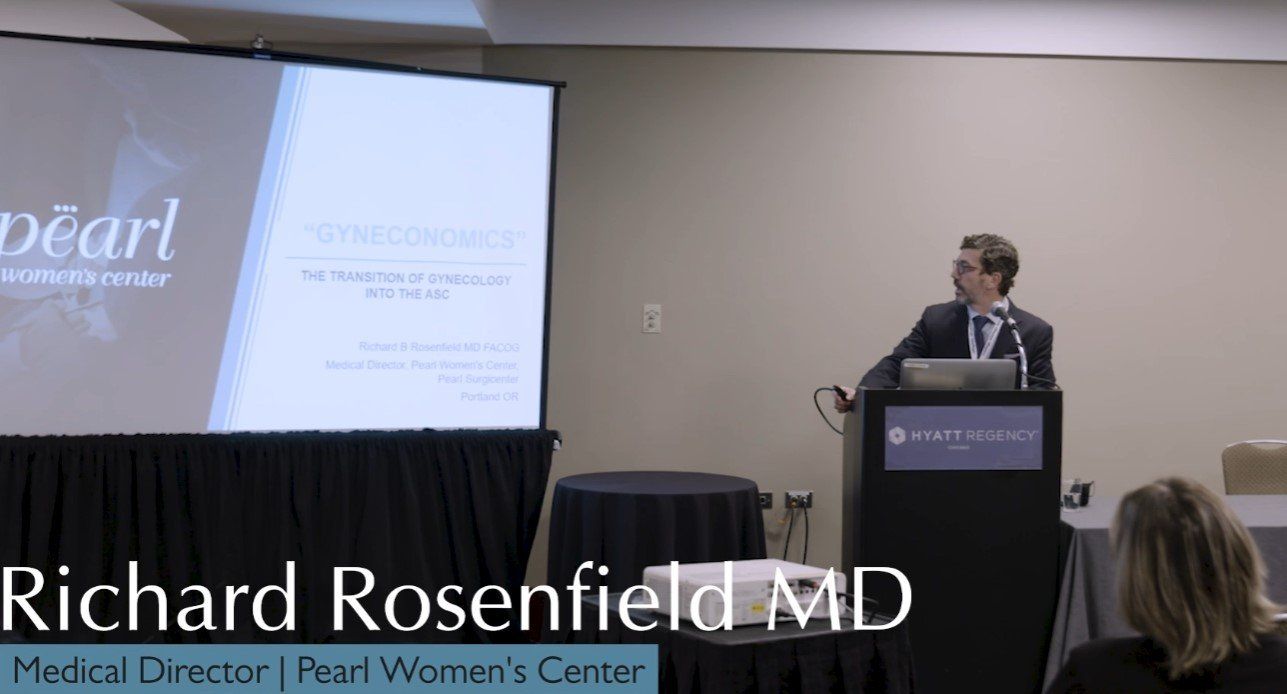Article on WebMD – A Fresh Look at Hysterectomy
A great article on WebMD here:
Last year, Nicole was miserable — heavy periods, lots of cramping. Not only did she have fibroids, but her uterus and bladder were slipping downward, causing serious discomfort. Nicole needed a hysterectomy, plus bladder repositioning, her doctor said.
He advised her that abdominal hysterectomy was the best option — “so they could see everything clearly,” she tells WebMD. That involves a big incision in the abdomen, about two days in the hospital, and nearly two months of recovery.
“I didn’t like the idea of abdominal surgery,” Nicole says. “I work, and I have two kids. I knew I needed to be up and about to take care of my girls. I didn’t have time for the six- to eight-week recovery.”
That’s when she got a second opinion, which resulted in a total laparoscopic hysterectomy. It left almost no scar, and she had minimal downtime.
“The next morning, I pretty much walked out of the hospital,” she says. “By the second day, I felt wonderful. I never did take any of the pain medications. I didn’t have any pain.” Two weeks later, she was back at work.
Laparoscopic Hysterectomies
Nicole’s laparoscopic hysterectomy is a form of minimally invasive surgery. Laparoscopic surgery is used in gallbladder and appendectomy surgeries, and has been adapted to surgeries in cardiology, urology, and other fields.
But in gynecology, the acceptance of laparoscopy has come more slowly. Indeed, more than 600,000 hysterectomies are performed in the U.S. annually. While upwards of 80% are abdominal surgeries, they could be done as laparoscopic or vaginal hysterectomies, doctors say.
The trend is indeed moving in that direction — and the patient’s recovery is the biggest reason, says Nicole’s surgeon, F. Ralph Dauterive, MD, chairman of obstetrics and gynecology at Ochsner Health Center in Baton Rouge. “There’s a shorter hospital stay and recovery, compared to abdominal surgery, so your return to normal activity is quicker.”
Hysterectomy Recovery: A Quick Comparison
It’s easy to see why women opt for laparoscopic hysterectomy. Why suffer with a big incision if you don’t have to? Why have a month or more downtime if it’s not necessary? Compare the three options you have:
The standard abdominal hysterectomy is major surgery with a big belly incision, and a slow, painful recovery. Approximate recovery time: Six weeks.
The vaginal hysterectomy can be done entirely through the vagina, or using a laparoscope (the laparoscopic-assisted vaginal hysterectomy, or LAVH). Only women with a relatively small fibroid, small uterus, and no previous caesarean sections can have this. Approximate recovery time: Two weeks.
The total laparoscopic hysterectomy involves only small “keyhole” incisions, often made in the navel or abdomen. Approximate recovery time: Two weeks or less.
The Pros and Cons of Laparoscopic Hysterectomy
Nearly any woman is a good candidate for total laparoscopic hysterectomy — regardless the size of her fibroid or uterus, whether she’s had a caesarean section or not, explains Gladys Tse, MD, assistant professor of obstetrics and gynecology at Washington University School of Medicine in St. Louis.
But cost may be a factor to consider: A laparoscopic procedure generally takes longer and is more expensive than the standard abdominal hysterectomy. “The cost is double the cost of an abdominal surgery,” Tse says. “If you are in a PPO where you have to pay 20%, that may be an issue.”
The skill level among surgeons is another big issue. “You have to find someone who is very experienced, or they can do a lot of damage,” Tse says.
Most gynecologists can perform the laparoscopic-assisted vaginal hysterectomy (LAVH), which debuted in the late 1990s. But total laparoscopic hysterectomy is much newer — with the first cases performed in 2005, Tse explains.
“Among garden-variety gynecologists, not many are doing it. Or they’re performing the surgery without really knowing how to do it,” she says.
If the surgeon is not skilled, there is more risk to the patient, says Ted Lee, MD, director of the laparoscopy fellowship program at University of Pittsburgh School of Medicine. “Choose your surgeon carefully. Find someone you trust — and who is honest about whether you are really a good candidate for it. You don’t want a surgeon who is just doing the procedure to practice it.”
Finding the Right Surgeon for Your Hysterectomy
To find a skilled surgeon, Tse advises asking:
How many total laparoscopic procedures have you performed? An experienced surgeon will have performed at least 25 to 50, she says.
Also ask how many times the surgeon has started a laparoscopic procedure, then decided to switch to an abdominal incision, called the “conversion rate. ” A good surgeon’s conversion rate should be less than 5%, Lee explains.
Bottom line: Your surgeon needs to offer all the options. “If they are well-versed in all procedures, they can offer the patient appropriate care,” Lee tells WebMD. “Otherwise, it’s the old saying: If you only have a hammer, everybody’s a nail. A surgeon who has more tools can best serve the patient.”
Common Reasons for Hysterectomy
The common reasons for hysterectomy are:
uterine fibroids
severe vaginal bleeding
uterine prolapse
endometriosis
chronic pelvic pain
Hysterectomy is also used to treat uterine and cervical cancer.
Hysterectomy: Emotions and Alternatives
Depending on a woman’s age, the choice to have a hysterectomy can be an emotionally tough decision. It means that she can no longer have children. That’s the crux of hysterectomy — the uterus (or part of it) is removed.
“Hysterectomy is a very personal thing for women,” explains Tse. “Some are so thankful to be done with this troublesome organ. For others, there is grief over the loss of womanliness, their ability to have children.”
Today, women know they have many options, adds Katherine Hartmann, MD, PhD, vice-chairwoman of obstetrics and gynecology at Vanderbilt University School of Medicine in Nashville.
Medications and the IUD Marena can control heavy bleeding in some women.
A surgery called myomectomy can remove troublesome fibroids while leaving the uterus intact — a good option for women who want to have children.
Uterine artery embolization — destroying the lining of the uterus – can also reduce bleeding. So can endometrial ablation. But most women cannot get pregnant after endometrial ablation, and it’s not yet clear whether uterine artery embolization reduces chances of pregnancy.
“There is greater sense that we can work through this less aggressively … work to alleviate the symptoms, before choosing hysterectomy,” Hartmann tells WebMD. “It’s not as much an automatic choice as it might have been.”
Yet many opt for hysterectomy and are relieved that surgery can end difficult symptoms.
“They are just tickled,” says Hartmann. “These are women who have severe bleeding, and they just want the problem to end.”
For them, hysterectomy offers better quality of life, she says. “We see improvements in anemia, fatigue, pain, missed work days. There’s no more gushing bleeding that leads them to restrict their social lives. Satisfaction with sex life goes way up after hysterectomy, as they can have sex more often.”
A Critical Decision: Remove the Ovaries or Not?
Women considering a hysterectomy have a big decision to make: whether to have ovaries removed (oophorectomy). Removing a woman’s ovaries triggers the biggest side effects of hysterectomy — premature menopause. Unless a woman takes hormones, she will immediately go into menopause with all its hormonal changes and hot flashes.
A Critical Decision: Remove the Ovaries or Not? continued…
This is another opportunity to make an informed decision, Hartmann tells WebMD. If a woman is “seven to 10 years from natural menopause, she may choose not to do oophorectomy. We’re very much moving away from the ‘clean sweep’ approach … the thought that while we’re there, we’ll just take out the ovaries, too.”
However, women with inherited types of breast or ovarian cancer may decide to have their ovaries removed as preventive (prophylactic) procedure — to reduce cancer risk.
Because removing ovaries brings on sudden symptoms of menopause , including the possible loss of sexual desire, Tse usually advises women to keep their ovaries.
“Loss of libido can be very difficult to treat, because a woman’s libido is very complex — tied with hormones, self-image, her bond with her partner,” Tse says. “Unless there is a medical reason for it, we should not take the ovaries.”
The post Article on WebMD – A Fresh Look at Hysterectomy appeared first on Pearl Precision Surgery.




